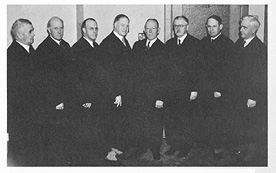Chief Justice William
Harrison Waste, Part 4
|
"Waste's opinions as a
Justice of the state Appellate Courts have commanded high respect,
and several have been selected by casebook editors to illustrate
legal principles.
Waste's judicial conservatism was
a matter of of principle. As an associate justice, he joined
in holding unconstitutional an initiative measure which received
a two-thirds vote of the electorate, although he was up for re-election
at the primary election within two months. The rights of an infant
American citizen of Japanese ancestory were upheld. |
|
His attitude was similar, when, as Chief
Justice, he later considered the Mooney case on writ of habeas
corpus. Public feeling ran high; efforts to discredit the fairness
of the trial court were national and international in scope. |
 |
 |
|
The day Frederick Houser
was sworn in as a Justice of the California Supreme Court, Oct.
5, 1937
(click on the images for
larger versions) |
|
Under Waste's leadership, the Court
gave careful consideration to the facts and law. The lengthy
but clear opinion largely disabused the public mind of the charges
that a perversion of justice had taken place. Within a year after
the Mooney decision Waste received over a million votes for re-election,
more than twice those cast for the opposition.
Waste's conservatism did not blind
him to the need for change and and he was aware that the Court
he joined had progressed into a new era while he was growing
up. He had not yet been born when Terry killed Senator Broderick
in a duel, but he was a college student when Field's body guard
shot Terry to death. His peaceful nature, typified by a gentle,but
strong-spirited, application of rule by principle and law without
violence, and his long tenure on the bench, were both appropriate
to his time and contrasted strongly with the extremes of pioneer
justice which still existed at the time of his birth. It was
during Waste's Chief Justiceship that the Court members began
wearing judicial robes. By the time the twenty-first Chief Justice
took office, the State had clearly come of age judicially, and
the pioneer era was over. |
 |
|
Chief Justice Waste swearing Carter
in as a justice, Sept. 12, 1939. It was during Waste's Chief
Justiceship that the Court members began wearing judicial robes.
(click on the image for larger
version) |
|
Waste was well aware of the growth,
development and consequent changes that had taken place on both
local and national levels during the relatively brief history
of our nation, and of the need for men of principle to guide
the process. In an address to five thousand Spanish-American
War Veterans in 1935, he recognized that there was an inherent
conflict in the historical development from the intense individuality
of revolutionary America to the complex interdependence of the
modern United States, and denied that there was any longer a
right in our modem society for "any substitution of private
will for public authority." "We cannot make men better
by making more laws", he observed, and quoted President
Coolidge that "there is no way by which we can substitute
the authority of law for the virtue of man."
Waste knew how men can become virtuous,
and in his personal life he quietly showed the way. A thread
of service to mankind ran through his conscientious devotion
to government and the law, leadership in his church, participation
in fraternal orders, and his long service to various civic groups.
Waste was so ill during the last
year of his life that he found it extremely difficult to carry
his share of the Court's work. An old heart ailment became critical
on May 23, 1940, and he died at his home in Berkeley in the late
afternoon of June 6. Justices Gibson, Edmonds, and Carter, and
the Clerk of the Supreme Court, B. Grant Taylor, were honorary
pallbearers at the funeral services conducted at the Scottish
Rite Temple in Oakland. Private services were held at Mountain
View Cemetery in Oakland, after which his urn was placed in Sunset
Cemetery near his Berkeley home.
Wilbur, then Senior Judge of the
United States Circuit Court of Appeals, Ninth Circuit, who had
been associated with Waste three years on the Supreme Court,
later said:
"No just estimate of Judge Waste can be made without taking
into account his frank and devoted adherence of the teaching
of Jesus Christ and his acknowledged obligation to follow the
Divine Leader as best he could at all times and under all circumstances.
He was determined to win in life, if he won at all, as an avowed
Christian. The public accepted Judge Waste as a sincere Christian
and registered approval again and again of his Christian character." |
Chief Justice Waste died
on June 6, 1940, Berkeley, California
William Harrison Waste and
Mary Ewing Waste lived 3 generations before mine. |